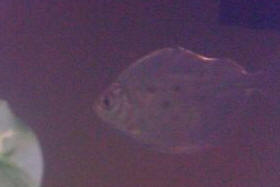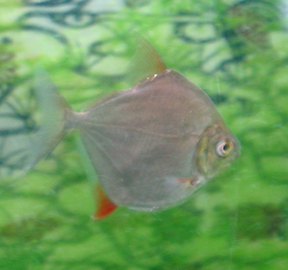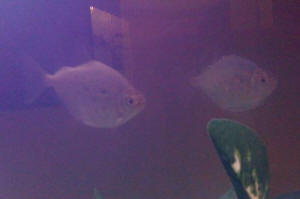|
FAQs on
Silver Dollars Identification
Related Articles: Serrasalmine Fishes, Piranhas, Characoids/Tetras &
Relatives,
FAQs on: Silver Dollars (Metynnis, Mylossoma,
Myleus...spp.) 1, Silver Dollars
2,
FAQs on:
Silver Dollar
Behaviour,
Silver Dollar
Compatibility,
Silver Dollar
Stocking/Selection,
Silver Dollar
Systems,
Silver Dollar Feeding,
Silver Dollar Health,
Silver Dollar Reproduction, Related
FAQs:
Serrasalmine Fishes,
Piranhas,
Pacus,
|

|
|
Silver dollar identification 3/30/11
Hello, Jim here. Thanks for your wonderful website. After 50
years of fish keeping, I found your website last November and
changed many bad habits. I'd like your help in
identifying the silver dollar in the attached photo. The red anal
fin led me to the Myleus rubriprinnis, but the second dorsal fin
on my fish is about as long as the first.
<Second dorsal fin? Do you mean the adipose fin? This is much
smaller than the dorsal fin. Quick reminder: Characins only have
a single dorsal fin.>
The finnage seems more like the Metynnis genus.
<Yes, would agree, and something like Myleus rubripinnis
rubripinnis, the Red-Hook Metynnis, would seem probable
here.>
Two identifying characteristics that don't
show up well in the photo are a white tip on the anal fin, and a
dark spot about ½' behind the eye and just
above the lateral line about the same size as the eye. This spot
is almost invisible when the fish is peaceful, but shades to
almost black when the school is going through
'pecking order' exercises. It is
darkest in the most dominant fish, and fades to very light in the
most submissive. There are no other spots on the fish at any
time. I Googled a photo of a Metynnis guaporensis that looks
close, but the underlying link wanted to search my system for
viruses. I didn't find a site that had much
information on this species. Fishbase has no photo, but a drawing
that seems improbable for a Metynnis.
<There are a great many species in this genus, plus the
similar genera Myloplus and Myleus. It is clear that more than a
single species have been imported under names like "Red Hook
Metynnis" over the years, and the photographs in aquarium
books are probably somewhat unreliable. The best approach is to
review Fishbase for this family:
http://www.fishbase.org/identification/specieslist.cfm?famcode=102&areacode=
In reality, telling some of these species apart depends on
microscope work, or at the very least, counting scales and fin
rays and other measurements you simply can't do with live
fish. The more common species in the trade are sold as Metynnis
hypsauchen, Myloplus rubripinnis, Metynnis lippincottianus and
Metynnis argenteus.>
I'm most interested in the size this fish will
attain, and secondarily in the life expectancy. The fish have
about doubled in length in 5 months. If they outgrow their tank
I'll have to find them a new home, as I
don't intend to install a larger tank.
<Do expect at least 15 cm. Be pleasantly surprised if they
stay smaller, but also be wary that 20 cm is not impossible, if
unlikely under aquarium conditions. As for lifespan, should be in
excess of 5 years, perhaps as much as 10 years if all is
well.>
I stocked (overstocked) this tank last November before I found
your site, and have since adjusted school sizes for silver
dollars and Corys up to present levels, and also added the Otos
to help with algae issues that I will get under control without
whining. Behavior has been good and improving both within and
between all species in the tank. For example, the silver dollars
have all but stopped the pecking order exercises that used to
occur several times a day. I expect the gouramis will thin out
naturally in about a year and a half if they
don't fall ill, but all the other tankmates
should be around a good while.
Thanks for all I've learned from nosing around
your entertaining site.
Jim
<Cheers, Neale.><<This is almost certainly a Metynnis
sp., likely Metynnis hypsauchen. RMF>>
|
|

|
|
Silver Dollar Fish spots and possibly bad water.
1/4/09 Hi, I recently discovered your site and my head
is spinning from all the recommends and good information! I wrote
you this week to ask about my Gourami's nipped fin and you
were extremely helpful. Now I have just discovered I probably
have two new problems. My Silver Dollars appear to be developing
spots. They are round dark gray spots that don't seem to
change the fish surface texture in any way. See the attached
pictures. The fish appear healthy in every other way; good social
life and very good appetites. And I really thought my tank was
cycled, but it's not and I'm fearing for the safety of
the fish. I relied upon unreliable chemical measurement devices;
quick dips. And used a lot of chemical products. Now, I'm
wondering if my two problems could be the same problem--bad tank
water causing Silver Dollar spots. All my other fish are doing
well, except for one of the Cory cats who is obviously very
lonely; eats well, but hides a lot. But I won't add more fish
until all these problems are resolved. To sum up, here are My
Questions 1. What do my Silver Dollars have? 2. How do I fix
whatever it is they have? 3. Where did I go wrong with tank
upgrade cycling? 4. How do I fix the tank upgrade cycling
situation? The Story. I thought the spots were natural coloring
on the two largest of my Silver Dollars; I have three of them.
Then today I visited my LFS and spent some time observing their
Silver Dollars--none of them had spots. When I returned home, I
noticed the smallest of my three now had spots when there
hadn't been any before. Plus I realized the spots on the
other two had become more numerous. I guess that means it's
more than natural coloring. I'd like to know if this is a
sort of disease and what I can do about it. General information
regarding the tank is below. But here is some history that can be
helpful in diagnosis, I hope. A month ago, I upgraded from a 10
gallon tank to a 50 gallon tank. To cycle the new water, I
transferred about 7 gallons of water from the 10-gallon tank into
the new 50-gallon tank, inserted filter material from the
10-gallon tank into the new tank filter system and used the
Stability product (described below) as directed--except I
extended it's use from one week to two & a half weeks. So
as to let the good bacteria build up, I've only done one
partial water change with the new tank--I vacuumed the bottom and
changed out about five gallons of water. I'm wondering if my
Silver Dollars have a bacterial infection from overuse of the
Stability product. But that's confusing because the bottle
specifically stated there was no danger in over use.
Stability-New Tank Stabilization System. What follows is a quote
from the bottle. "a synergistic blend of aerobic, anaerobic
and facultative bacteria which facilitate the breakdown of waste
organics, ammonia, nitrite, and nitrate. The bacteria employed by
Stability are non-sulfur fixing and will not produce toxic
hydrogen sulfide. Stability is completely harmless to all aquatic
organisms as well as aquatic plants, thus there is no danger of
over use." Using the quick-dip test sticks left over from my
smaller tank, I thought my upgraded tank was cycled. After
reading your web site I decided a more precise measure of tank
chemicals was in order and bought some test kits today,
(that's what I was doing at the LFS). I learned two things.
One, the color charts on these kits are very hard to read. Two,
my tank has NOT cycled. I obtained the following readings.
Nitrite NO2 = 1.0 ppm NO3 = 5.0 ppm So now I'm thinking maybe
the Silver Dollars have been stressed out all this time and the
stress led to the development of a bacterial infection OR that
the high level of NO2 has done something to the fish. I really
thought adding the old water from the 10-gallon tank and old
filter material would have sped the cycling process along. The
final thing I can think of is that I had a ph problem for 4-6
weeks, the water was acidic, around 6.2. About one and a half
weeks ago, two heavy doses (about 5 days apart) of a ph regulator
brought it up to 7. Could the spots be related to water acidity?
After much reading on WWM I've decided I'm probably
overfeeding and will reduce feedings to one type of food once
daily and cut out the proteinaceous shrimp until tank properly
cycles. My LFS owner told me that my fish will survive the high
NO2 and NO3 and that the tank will probably finish the cycling
within 2 or 3 days. I'm not as confident as he is and am
worried about the toxicity of my tank and the health of the fish
in it. Tank information. 50 gallon tank: 19" high, 48"
long, 12" wide; Ph=7 ; Lots of hiding
places-huts/caves/arranged stones; Lots of fake plants of
differing texture, height and density; No live plants;
Filtration=two Aqua Clear filters, each for 40-70 gallon tank;
Temp: 79 degrees; Food: Daily, Aqueon tropical flakes and Hikari
tropical micro pellets; weekly, frozen brine shrimp; most days,
spinach, romaine lettuce or other nutritious greens. Fish
transferred from 10-gallon tank to 50-gallon tank 9 Neon Tetras
(one died since) 3 Rainbow Tetras 3 Emperor Tetras 3 Albino Cory
Catfish (one died since) Fish added to above fish in 50-Gallon
upgrade 1 Pearl Gourami 3 Silver Dollars 3 Buenos Aires
<Greetings. The short answer is that several "Silver
Dollar" species are on sale, and some of them have black
spots. Yours may well be Metynnis maculatus, the Spotted
Metynnis, a species that gets to 18 cm in length and according to
Fishbase at least is known to give serious bites, so be careful!
Silver Dollars are vegetarians to be sure, but they have strong
jaws just like their very close relatives the Piranhas.
http://www.wetwebmedia.com/FWSubWebIndex/serrasalminae1.htm
Anyway, as for cycling. The truth is that these "bacteria in
a bottle" products are often very hit-and-miss, and cynic
that I am, any product that advertises itself with the word
"synergistic" rings all kinds of alarm bells with me.
It's one of those buzzwords used by marketers rather than
engineers most of the time, like "holistic" and
"wholesome". So if you went "wrong" anywhere,
it was probably in assuming that this product would do what it
said it would. The reality of life is that cycling tanks is best
done by introducing obviously live biological media -- e.g., live
rock (in marine tanks) or mature filter media (all types of
tanks). Assuming you have at least one mature filter from the 10
gallon tank, dividing up its biological media into the two large
filters on the big tank should jump start them very effectively,
and I'd expect these new filters to settle down within a week
if "seeded" this way. In the interim, don't feed
the fish much (if at all) and do lots of generous water changes
to keep nitrite below 0.5 mg/l. With luck, that'll get you
through the worst of things, and you'll be fine. Cheers,
Neale.> Thank you. There's a wonderful place for you
fish-guys in heaven! <What a kind thought! Happy to help,
Neale.>
|
  |
Sick Silver Dollars (no, they're really not!)
8/18/08 Hello Robert I am having some problems
again.. You've been extremely helpful in the past.. I have a small
shoal of silver dollars, 15 total.. 2-3 of the fish have reddish spots
or splotchiness on their bodies. <Normal for sexually mature (male)
Myloplus rubripinnis "luna".> 1 in particular has it bad..
They have been that way for approx. 18 months or so.. When I got them I
had quarantined for 3 months due to some Ich and what looked to be some
sort of secondary infection from the Ich.. The red spots have always
been there just less noticeable at times.. 1 fish has it particularly
bad.. It hasn't affected his/her behaviour at all. He swims with
the rest and eats like crazy.. They are living in a 240 with misc other
fish.. Bichirs, Endlis, Distichodus, Niger Cats, Asian Redtail Cats,
Assorted Cichla and a large Flagtail Prochilodus.. <Nothing to worry
about.> I have attached links to where I have some pics of them
saved on the net to reduce the size of this email.. If you want the
originals you can take them in whatever size you want from my Flickr
link or let me know and I can attach them in whatever size you need..
Thanks Doug Here is the link to the picture set. http://www.flickr.com/photos/fishnfst/sets/72157608166578919/
<Nice photos! Cheers, Neale.>
Re: Sick Silver Dollars (no, they're really not!)
10/19/08 Wow thanks for the quick reply.. I'm glad that
they aren't sick :) I saw some with the same markings at the
California academy of sciences today.. <Sounds a fun day!> I
thought maybe theirs were sick as well.. Now I know... Those are the
males... <Indeed.> Thanks Again Neale.. Doug <Happy to help.
Enjoy your fish! Cheers, Neale.>
Tom... need titles to find/match prev. corr... 9/28/06 ? Pacus,
Serrasalmine IDs... Tom, <<Hi, Lisa.>> Oh,
I'm so confused! Well, my cousin said that I had a
cichlid? I know for sure that I had at least one I know for sure is a
silver dollar. . . ( I had two) But maybe it's a
Pacu? <<Could be... These two, and Piranhas, are sometimes
confused at the juvenile stage. As they mature, the differences become
more obvious.>> Is there any kind of difference between a Pacu
and a Silver Dollar? <<Oh, Lord, yes! Sorry about the emphasis
but if you have a Pacu as opposed to a Silver Dollar, you'll need a
300-gallon aquarium to keep it. Not likely, I'm thinking. :) Now, a
Piranha might have a distinct taste for your other fish.>> I know
for a fact it was eating my fish because one day I saw parts of what
was left of my fish chomping on it! I really did get the memo.. Just
its wrong.. ( haha) Yes, its very
'nervous' I
can't even turn on the light in the tank and it goes
crazy. <<Again, this is common of Pacus, which is why they fall
into the "tank buster" category. They can/will
"frenzy" themselves into anything and everything in the tank.
Not what you want in a fish that reaches 30+ inches in length and can
weigh upwards of 55 lbs. or more.>> My fish is not typical in any
way. Oh, I think this is kind of funny. When I was cleaning my tank I
noticed my fake plant had gnawing marks all over them. I wonder who
that was from'¦ <<Silver Dollars and Pacus,
both, will eat aquarium plants of just about any variety. (There are
some plants that folks have found that won't get devoured but most
of those that you'll find readily at the fish store will be turned
into "lunch" sooner or later.)>> Okay for the
filters'¦ even if you have charcoal, they
don't get the bad stuff out- thought it got the
'invisible solids' out?
<<Activated carbon does a very nice job of "polishing"
the water of hard-to-eliminate solids but does nothing for ammonia and
nitrites.>> Um, I usually clean the filter when it gets kind of
bad. Hard to get the stuff out, I change it. I'm
such a bad fish keeper! Definitely getting an F'¦
(haha) I'm guessing you are an aquarist yourself? <<Yes,
indeed.>> If so fresh or saltwater? <<Strictly freshwater
at this point in time, Lisa.>> Yes, I do wish there was more time
in the day. That would be nice'¦ Lately I been going
to bed kind of early 9-10. I guess my body isn't in
the swing of school yet. Should I tell the person about the worms? Or
keep and eye out on the tank? ( I'm scared to tell
him.) <<As I suggested, Lisa, the problem is with the tank, not
the fish. If your friend's tank comes down with Planaria, it will
be due to water conditions in his aquarium, not the fish you gave him.
You're off the hook! :)>> I'm sorry
I'm bombarding with a lot of questions. <<Any
time, Lisa. Tom>>
|
|

